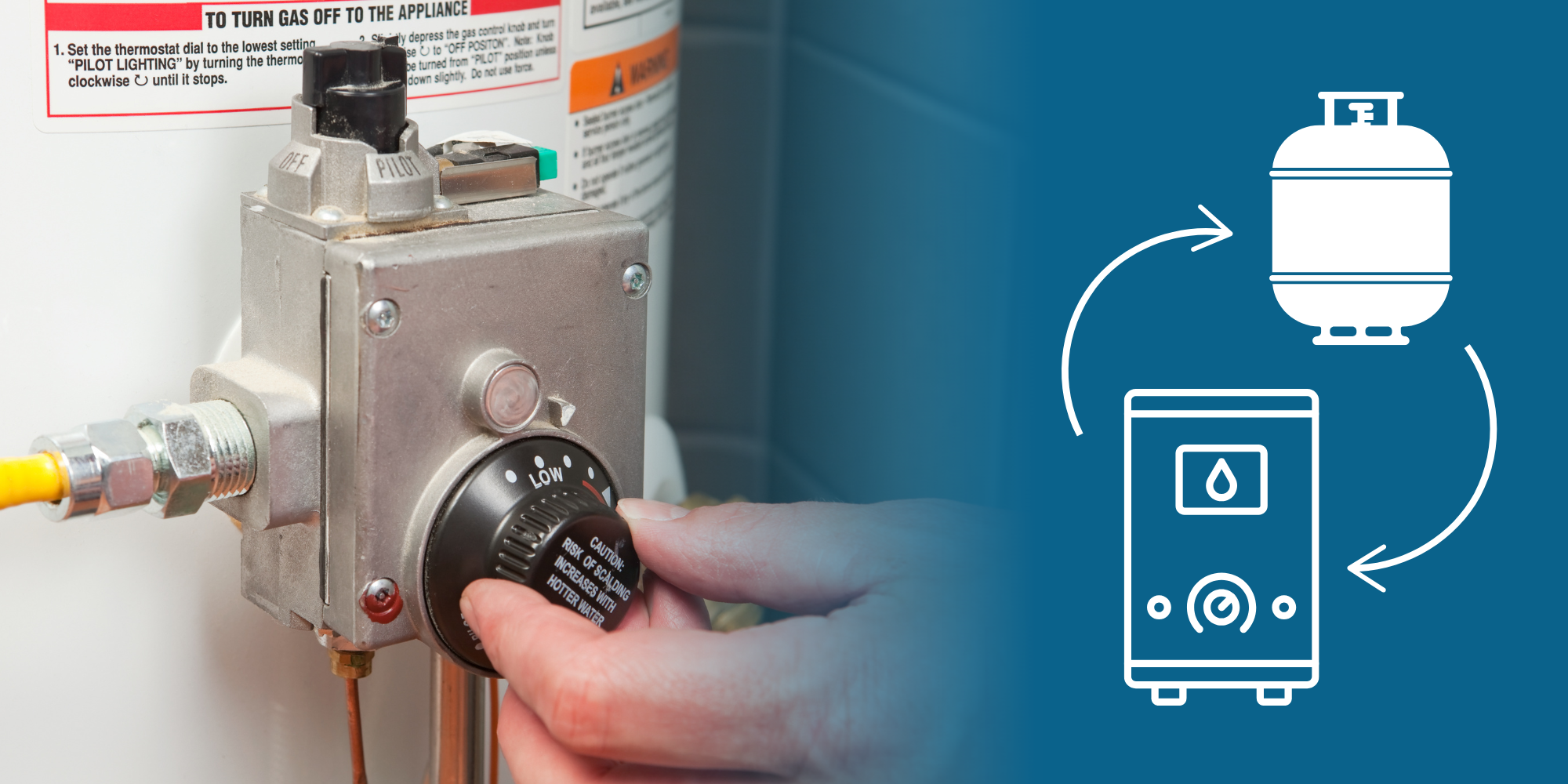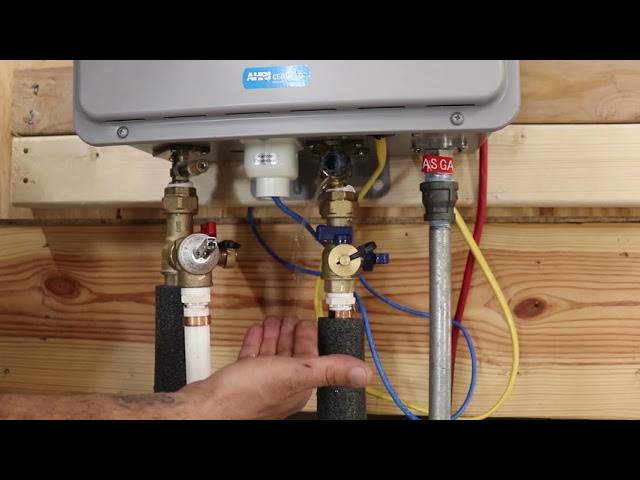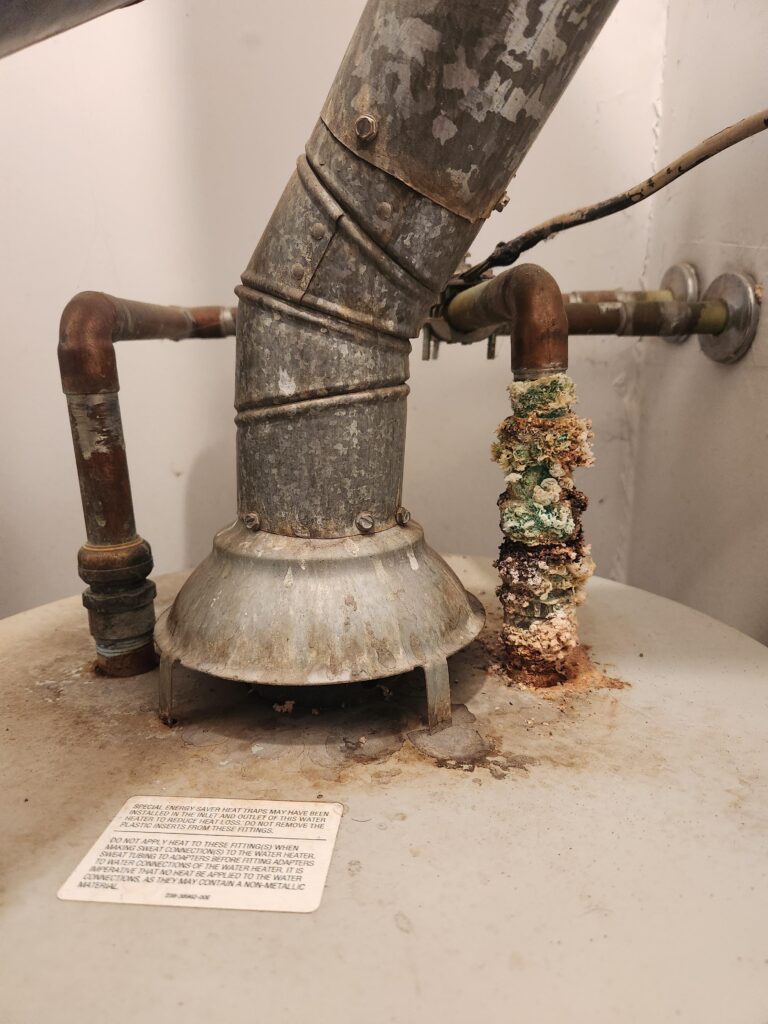Are you considering converting your propane water heater to natural gas? This guide is here to help you make a well-informed decision.
Switching to natural gas can offer you multiple benefits, like cost savings, increased efficiency, and a smaller carbon footprint. However, this process requires careful planning and execution to ensure safety and compliance with local regulations. You’ll discover the step-by-step process, potential challenges, and expert tips to make the transition smooth and hassle-free.
By the end, you’ll feel confident in your ability to make the best choice for your home and family. Stick with us, and let’s dive into the details together!

Credit: www.kauffmangas.com
Safety Precautions
Converting a propane water heater to natural gas demands careful attention to safety. Proper precautions can prevent potential hazards and ensure a smooth transition. Follow these guidelines to make the process safe and efficient.
Identify Potential Risks
Assessing risks is crucial before starting the conversion. Propane and natural gas have different properties. Mixing them improperly can cause leaks or explosions. Inspect all components to ensure compatibility. Seek advice from a professional if unsure.
Use Proper Safety Gear
Wearing the right safety gear protects you from accidents. Gloves and goggles are essential for handling gas connections. A fire extinguisher nearby adds an extra layer of safety. Make sure your safety gear is in good condition before starting.
Ventilation Requirements
Proper ventilation is critical during conversion. Gas fumes can be dangerous if inhaled. Ensure the area is well-ventilated to prevent gas buildup. Open windows and doors or use fans to circulate air. Ventilation keeps the work area safe and breathable.
Tools And Materials
Converting a propane water heater to natural gas requires specific tools and materials. Essential items include a wrench set, gas conversion kit, and pipe sealant. Proper safety gear like gloves and goggles is also needed for protection during the conversion process.
Converting a propane water heater to natural gas can be a smart move. It offers potential savings on energy costs and is often more environmentally friendly. Before you begin, having the right tools and materials is crucial. This preparation ensures your project runs smoothly and safely. Let’s dive into what you’ll need.Essential Tools List
When tackling any DIY project, having the right tools is half the battle. Here’s a list to get you started: – Adjustable Wrench: Essential for loosening and tightening fittings. – Pipe Cutter: Ensures clean and precise cuts on your piping. – Pipe Wrench: Provides extra grip and torque for stubborn connections. – Screwdriver Set: Versatile for various screws and fasteners. – Gas Leak Detector: A must-have for ensuring your connections are safe and secure. Each of these tools plays a crucial role. Imagine trying to cut a pipe without a cutter; you’d end up with jagged edges and a poor fit. Trust me, I’ve been there, and it’s not worth the hassle.Materials Needed
Beyond tools, you’ll need specific materials to complete the conversion effectively. Here’s what you’ll need: 1. Natural Gas Conversion Kit: The heart of your project. It typically includes necessary fittings and orifices. 2. Flexible Gas Line: Allows for easy connection between your gas supply and water heater. 3. Pipe Sealant Tape: Ensures a tight, leak-free seal on threaded connections. 4. New Burner Orifice: Designed specifically for natural gas flow rates. 5. Gas Shutoff Valve: Allows you to safely control the gas flow. Imagine the frustration of starting your project only to realize you’re missing a critical component. By having everything ready, you avoid unnecessary trips to the hardware store. Have you ever started a project and found yourself halfway through only to realize you’re missing a tool or material? It disrupts your flow and adds unnecessary stress. Getting your toolkit and materials ready beforehand keeps you focused and efficient. Are you ready to get started?Gas Compatibility Check
Converting a propane water heater to natural gas demands careful planning. One key step is the gas compatibility check. This ensures your heater can safely and efficiently use natural gas. It’s crucial to avoid any safety hazards or inefficiencies. Below are steps to ensure your heater is compatible.
Identify Heater Model
First, identify the model of your water heater. The model number is usually on a label. This label may be on the side or back of the heater. Knowing the model helps in finding specific information. Each model has unique specifications and requirements. This step is vital for accurate compatibility verification.
Consult Manufacturer Guidelines
Next, check the manufacturer’s guidelines. These guidelines provide crucial details. They often state if conversion is feasible. They may also outline necessary modifications. Manufacturer guidelines ensure you follow safety protocols. They are a reliable source of information for compatibility checks.
Conversion Kit Selection
Converting a propane water heater to natural gas requires a conversion kit. Selecting the right kit is crucial for a safe and efficient conversion. This section guides you through the process of choosing the right conversion kit. Understanding the types available and making an informed choice ensures success.
Types Of Conversion Kits
Conversion kits come in different types. Some kits are universal, fitting various models. Others are model-specific, designed for particular heaters. Universal kits offer flexibility but may need adjustments. Model-specific kits provide a precise fit and often require less tinkering.
Each kit usually includes orifices, valves, and instructions. These components are essential for converting fuel systems. Always check the kit’s components match your heater’s requirements. Compatibility ensures a smooth conversion process.
Choosing The Right Kit
Begin by identifying your water heater model. Check the manufacturer’s guidelines for compatible kits. This step prevents buying the wrong kit. Consider the expertise required for installation. Some kits are user-friendly with clear instructions. Others might need a professional touch.
Cost is another factor to consider. Prices vary based on kit type and components. Balancing cost with quality is key. An inexpensive kit might save money upfront but lead to future issues. Investing in a reliable kit ensures safety and longevity.
Seek reviews and recommendations. Fellow users’ experiences can guide your decision. They provide insights into kit performance and ease of installation. Making an informed choice leads to a successful and safe conversion.
Disconnecting Propane Supply
Disconnecting the propane supply is crucial when converting a water heater to natural gas. Ensure safety by carefully shutting off the propane valve and removing connections. This step prevents leaks and ensures a seamless transition to natural gas, enhancing the efficiency of your heating system.
Disconnecting the propane supply is a crucial step. It ensures safety before converting a water heater to natural gas. This process involves shutting off the gas supply and removing propane connections. Follow this guide to safely disconnect the propane supply.Shut Off Gas Supply
Locate the main propane valve. It’s usually near the propane tank. Turn the valve clockwise. This stops the gas flow. Double-check that the valve is completely closed. This simple action prevents any gas leaks. It’s essential for safety. Make sure no appliances are running. This avoids accidents during the process.Remove Propane Connections
First, find the propane line connected to the heater. Use a wrench to loosen the fittings. Carefully detach the propane hose. Inspect the connections for any wear. Replace if necessary. Proper removal prevents damage to the system. Always handle connections gently. Avoid unnecessary force to prevent breakage.
Credit: servicewhale.com
Installing Natural Gas Components
Switching from a propane to a natural gas water heater involves careful planning. The process requires installing specific components to ensure safety and functionality. Understanding these steps is crucial for a seamless transition. This guide provides insights into essential tasks, like attaching a new gas line and installing a natural gas burner. These steps are vital for a successful conversion.
Attach New Gas Line
The first step is attaching the new gas line. Begin by shutting off the main gas supply. This ensures safety during installation. Next, remove the existing propane line carefully. Use a wrench to loosen connections. Once removed, install the new natural gas line. Ensure the line is the correct size for your heater. Tighten all connections securely. Check for leaks using a soapy water solution. Any bubbles indicate a leak. Address leaks immediately to prevent hazards.
Install Natural Gas Burner
After the gas line, focus on the burner. Remove the existing propane burner from the heater. This allows room for the new burner. Ensure the new burner is compatible with your heater model. Install the natural gas burner, following manufacturer instructions. Secure it in place, ensuring proper alignment. Connect the burner to the newly installed gas line. Double-check all connections for safety. Test the burner operation once installed. Adjust settings for optimal performance.
Testing For Leaks
Testing for leaks is crucial after converting a propane water heater to natural gas. Ensure all connections are secure and check for gas odors. Safety first to prevent accidents.
Testing for leaks is a crucial step when you convert a propane water heater to natural gas. Ensuring your connections are secure and leak-free is essential for safety and efficiency. It might seem daunting, but with careful attention, you can confidently verify the integrity of your gas lines. It’s not just about peace of mind—leak testing protects you and your home. Imagine the relief of knowing your setup is secure.Pressure Testing
Pressure testing is a fundamental method to check for gas leaks. Start by shutting off the gas supply and using a pressure gauge to monitor the system. You can attach the gauge to a test port and pressurize the system with air. Watch the gauge closely for any drop in pressure, which indicates a leak. Do you notice any fluctuations? If the pressure remains steady, your system is likely leak-free.Soap Solution Test
The soap solution test is a simple yet effective way to detect leaks. Mix water and a bit of dish soap in a spray bottle. Spray the solution generously over all connections and joints. Watch for bubbles forming, as this indicates escaping gas. It’s a straightforward test that can save you trouble down the line. Have you ever thought something so simple could be so effective? These tests are not just about fixing problems—they prevent them. They ensure your new natural gas setup runs smoothly and safely. Don’t skip them; they’re your best defense against potential hazards.Adjusting Burner Settings
Adjust burner settings carefully to convert a propane water heater to natural gas. Ensure proper safety measures are followed. Adjustments involve changing orifices and regulators for efficient operation.
Adjusting burner settings is a crucial step in converting a propane water heater to natural gas. Proper adjustments ensure safety and efficiency. Incorrect settings can lead to poor performance or hazards. This section guides you through setting correct pressure and adjusting the flame. Both are essential for optimal operation. Follow these steps to make sure your conversion is successful.Set Correct Pressure
The pressure setting is vital for natural gas burners. Propane and natural gas have different pressure requirements. Check the manufacturer’s manual for the ideal pressure. Use a manometer to measure the pressure. Adjust the gas valve until you reach the recommended pressure. Correct pressure ensures efficient burning and prevents leaks. Safety must always be your priority.Flame Adjustment
Flame adjustment impacts the heater’s performance. Natural gas flames should be blue with a small yellow tip. A yellow flame indicates incomplete combustion. Use a screwdriver to adjust the air shutter. Open the shutter gradually while observing the flame. Stop when the flame turns blue and steady. This adjustment improves efficiency and reduces soot buildup. Proper flame adjustment enhances the heater’s lifespan.Regulatory Compliance
Converting your propane water heater to natural gas involves more than just swapping parts; it requires adherence to regulatory compliance for safety and legality. Understanding and meeting these regulations is crucial to ensure a smooth conversion process and avoid potential pitfalls. Let’s dive into the specifics of local building codes and certification requirements to help you navigate this journey effectively.
Local Building Codes
Local building codes can vary significantly from one area to another. It’s essential to familiarize yourself with the codes specific to your location. These codes ensure that your conversion meets safety standards and fits within the local infrastructure.
Check with your local municipality or building department for specific guidelines. They often provide detailed information on what modifications are allowed and what permits you need. Neglecting this step could lead to costly fines or the need to redo the work.
Imagine starting a conversion only to find out halfway that your setup doesn’t comply with local codes. Save yourself the headache by thoroughly researching and preparing beforehand. Have you checked your local building codes yet?
Certification Requirements
Certification requirements are another critical aspect of regulatory compliance. Depending on your region, you may need to have the conversion certified by a professional. This certification ensures that the work has been done correctly and safely.
Look for technicians who are certified in both propane and natural gas systems. Their expertise will be invaluable in ensuring the conversion is up to standard. Ask yourself, would you trust an uncertified technician with something as crucial as your home’s heating system?
Having the conversion certified not only guarantees safety but also peace of mind. You can rest easy knowing that your system is functioning properly and legally. Don’t underestimate the power of a certified seal of approval.
Addressing regulatory compliance is not just a box to tick; it’s a fundamental step in ensuring the safety and efficiency of your conversion. So, before you start, have you considered all the regulatory angles?

Credit: harubina.co.jp
Maintenance Tips
Maintaining your converted water heater ensures it runs smoothly. Regular care can prevent issues and extend its lifespan. Focus on inspections and cleaning to keep it efficient. These tasks are simple and effective.
Regular Inspection Schedule
Create a monthly inspection routine. Check for any leaks or unusual noises. Ensure all connections are secure. Look for signs of wear or damage. Inspecting regularly can catch problems early. This saves time and money in the long run.
Cleaning And Servicing
Clean the water heater every few months. Remove dust and debris from around the unit. This helps it run efficiently. Check the burner and pilot light. Make sure they are clean and working well.
Service the heater annually. This keeps it in top condition. A professional can check safety features. They can also adjust settings for optimal performance. Regular servicing ensures your heater remains safe and efficient.
Conclusion
Converting your propane water heater to natural gas can save money. Natural gas is often cheaper and more efficient. This switch also benefits the environment by reducing emissions. Safety is crucial; always consult a professional. They ensure the conversion is done correctly.
This prevents accidents and problems later. Double-check all connections and seals. Make sure everything is secure and airtight. Enjoy the benefits of natural gas while being safe. It’s a smart choice for your home. Feel confident in your energy savings and environmental impact.


